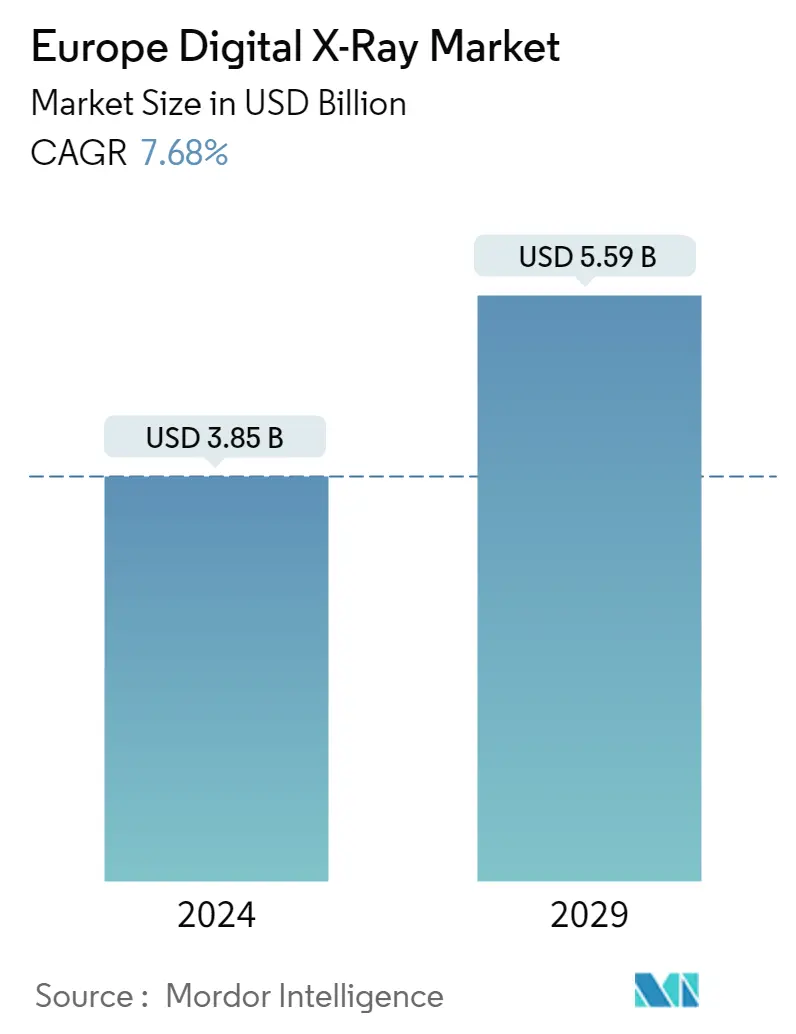Market Size of Europe Digital X-Ray Industry

| Study Period | 2021 - 2029 |
| Base Year For Estimation | 2023 |
| Forecast Data Period | 2024 - 2029 |
| Market Size (2024) | USD 3.85 Billion |
| Market Size (2029) | USD 5.59 Billion |
| CAGR (2024 - 2029) | 7.68 % |
Major Players
*Disclaimer: Major Players sorted in no particular order |
Europe Digital X-Ray Market Analysis
The Europe Digital X-Ray Market size is estimated at USD 3.85 billion in 2024, and is expected to reach USD 5.59 billion by 2029, growing at a CAGR of 7.68% during the forecast period (2024-2029).
The COVID-19 pandemic turned the spotlight on diagnostic imaging, particularly on Europe's digital X-ray devices. Digital imaging plays a key role in diagnosing COVID-19 in Europe and indicates the affected lung tissue in infected patients. Several key market players in Europe have focused on innovations in the production of radiography equipment. For instance, in November 2020, Agfa HealthCare launched its SmartXR for X-ray Artificial Intelligence (AI) for Digital Radiography portfolio to aid the radiology routine, which has proven important during the COVID-19 crisis. The efficacy of digital X-ray systems in diagnosing COVID-19 infections drove the demand during the pandemic period. However, currently, there is a decrease in imaging volume, particularly due to a decrease in COVID-19 cases. Still, the emergence of various other mutant virus strains of COVID-19 and the use of digital X-rays for other modalities will increase the demand for digital X-rays.
The factors that are responsible for the growth of the market include increasing incidence of diseases requiring X-ray diagnoses, such as orthopedic diseases, cancers, etc., increasing technological advancements, and advantages of digital X-rays over conventional X-rays.
The increasing incidence of chronic diseases is expected to be the crucial driving factor for the growth of the market. For instance, according to the IARC data in October 2021, the cervical cancer crude incidence rate among females in Italy was 10.2. The incidence rate of oral cavity cancer was 8.04 in males and 5.38 in females. Similarly, in the same source, in Italy, the crude prevalence of vaginal cancer among females was 0.76 and the incidence rate of anal cancer among males was 1.38. Thus, increasing the incidence of cancer cases is more likely to drive the market for digital X-rays.
Additionally, the MDPI Journal research article published in September 2021 reported that the worldwide prevalence of peripheral arterial disease (PAD) is estimated to be 3-12%, affecting nearly 27 million people in Europe. The same source also reported that in Europe, the prevalence of PAD is estimated at around 17.8% between the ages of 45 and 55. These studies show the high burden of peripheral vascular diseases, which is another factor boosting the market's growth.
Furthermore, the increasing launches of advanced digital X-rays in Europe by various market players are also expected to contribute to the growth of the market. For instance, in March 2021, Konica Minolta launched AeroDRX90, a high-end auto-positioning X-ray system, at the European Congress of Radiology virtual exhibition. The Aero DR X90 was a highly ergonomically designed system that used auto-positioning, auto-tracking, and auto-stitching to help drive an efficient workflow. Launches of such innovative products are expected to contribute to the growth of the market.
Thus, due to factors such as the growing prevalence of chronic diseases, rising demand for effective diagnostic equipment, and innovative product launches by various market players, the market is expected to witness significant growth over the forecast period. However, the high initial cost of installation and new sales affected by the increasing use of the refurbished device and stringent regulations are expected to hinder the market growth.
Europe Digital X-Ray Industry Segmentation
Digital X-ray or digital radiography is a form of X-ray imaging where digital X-ray sensors are used instead of traditional photographic films. This has the added advantage of time efficiency and the ability to transfer images digitally, as well as enhance them for better visibility. This method bypasses the chemical processing of photographic films. Digital X-ray imaging has high demand, as it requires less radiation exposure than traditional X-rays.
The European Digital X-Ray Market is segmented by Application (Orthopedic, Cancer, Dental, Cardiovascular, and Other Applications), Technology (Computed Radiography and Direct Radiography), Portability (Fixed Systems and Portable Systems), End-user (Hospitals, Diagnostic Centers, and Other End-users), and Geography (Germany, United Kingdom, France, Spain, Italy, and Rest of Europe). The report offers the value (in USD million) for the above segments.
| By Application | |
| Orthopedic | |
| Cancer | |
| Dental | |
| Cardiovascular | |
| Other Applications |
| By Technology | |
| Computed Radiography | |
| Direct Radiography |
| By Portability | |
| Fixed Systems | |
| Portable Systems |
| By End-user | |
| Hospitals | |
| Diagnostic Centers | |
| Other End-users |
| By Geography | |
| Germany | |
| United Kingdom | |
| France | |
| Spain | |
| Italy | |
| Rest of Europe |
Europe Digital X-Ray Market Size Summary
The European digital X-ray market is poised for significant growth, driven by the increasing prevalence of chronic diseases and the rising demand for advanced diagnostic equipment. The market has gained momentum due to the COVID-19 pandemic, which highlighted the critical role of digital imaging in diagnosing infections. Innovations in radiography equipment, such as Agfa HealthCare's SmartXR for X-ray AI, have further propelled market expansion. Despite a temporary decline in imaging volume post-pandemic, the emergence of new virus strains and the continued use of digital X-rays for various medical conditions are expected to sustain demand. The market's growth is also supported by technological advancements and the advantages of digital X-rays over traditional methods, making them a preferred choice for diagnosing orthopedic diseases, cancers, and cardiovascular conditions.
Germany is a key player in the European digital X-ray market, driven by the adoption of sophisticated healthcare technologies and a high incidence of road accident injuries. The country's substantial volume of cardiovascular procedures necessitates effective diagnostic tools, boosting the demand for digital X-rays. Collaborative partnerships and strategic market initiatives, such as Philips' partnership with University Hospital Brandenburg, are expected to further enhance market growth. The competitive landscape is dominated by major companies like GE Healthcare, Philips, Fujifilm Holdings, Siemens Healthineers, and Canon Medical Systems, which continue to introduce innovative products to meet the evolving healthcare needs. Despite challenges such as high initial costs and regulatory hurdles, the market is set to expand, supported by the increasing incidence of chronic diseases and the ongoing development of advanced digital X-ray systems.
Europe Digital X-Ray Market Size - Table of Contents
-
1. MARKET DYNAMICS
-
1.1 Market Overview
-
1.2 Market Drivers
-
1.2.1 Growing Incidence of Diseases Requiring Diagnosis and Rising Aging Population
-
1.2.2 Technological Advancements and Increasing Spectrum of Applications
-
1.2.3 Advantages of Digital X-ray Systems over Conventional X-rays
-
-
1.3 Market Restraints
-
1.3.1 High Initial Cost of Installation and New Sales Affected by Increasing Use of Refurbished Device
-
1.3.2 Stringent Regulations and Poor Reimbursement
-
-
1.4 Industry Attractiveness - Porter's Five Forces Analysis
-
1.4.1 Threat of New Entrants
-
1.4.2 Bargaining Power of Buyers
-
1.4.3 Bargaining Power of Suppliers
-
1.4.4 Threat of Substitute Products
-
1.4.5 Intensity of Competitive Rivalry
-
-
-
2. MARKET SEGMENTATION (Market Size by Value - USD Million)
-
2.1 By Application
-
2.1.1 Orthopedic
-
2.1.2 Cancer
-
2.1.3 Dental
-
2.1.4 Cardiovascular
-
2.1.5 Other Applications
-
-
2.2 By Technology
-
2.2.1 Computed Radiography
-
2.2.2 Direct Radiography
-
-
2.3 By Portability
-
2.3.1 Fixed Systems
-
2.3.2 Portable Systems
-
-
2.4 By End-user
-
2.4.1 Hospitals
-
2.4.2 Diagnostic Centers
-
2.4.3 Other End-users
-
-
2.5 By Geography
-
2.5.1 Germany
-
2.5.2 United Kingdom
-
2.5.3 France
-
2.5.4 Spain
-
2.5.5 Italy
-
2.5.6 Rest of Europe
-
-
Europe Digital X-Ray Market Size FAQs
How big is the Europe Digital X-Ray Market?
The Europe Digital X-Ray Market size is expected to reach USD 3.85 billion in 2024 and grow at a CAGR of 7.68% to reach USD 5.59 billion by 2029.
What is the current Europe Digital X-Ray Market size?
In 2024, the Europe Digital X-Ray Market size is expected to reach USD 3.85 billion.

